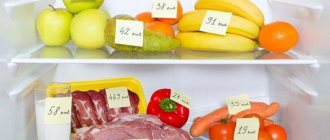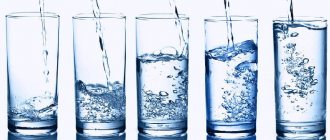Why did this problem occur?
There are several reasons.
- A lot of ready-made, processed foods have appeared in our diet.
- Sweet carbonated water and delicious desserts have become the norm.
- Working at a computer, lack of physical housework thanks to modern household appliances, traveling by car. Technological progress has given us comfort and extra weight as a bonus.
Now we have to do something with this “bonus”.
Have you decided to lose weight? Congratulations. The first step has already been taken. There is intention, but it is not enough.
Weight loss occurs when a person expends more energy than he consumes. This is called a negative energy balance. The body uses up energy reserves, starting with fat, to make up for the deficiency.
But it is worth considering that a person with a small amount of fat will spend more muscle tissue. This can lead to further health problems, including:
- high risk of osteoporosis
- decrease in muscle mass
- problems regulating body temperature
- weakened immune system
Calculation of human energy consumption for physical activity
So, exactly how many calories are spent on different types of physical activity? We have collected their most common types in one table.
| Calculation of energy consumption during training | |
| Type of occupation | Kcal/hour for every 1 kg of body weight |
| Intensive training (tennis, circular group classes, step aerobics, exercise bike, mountaineering, running from 15 km/h, fast swimming and dancing, handball, wrestling, boxing, skiing) | 7-12 |
| Moderate exercise (swimming, walking, gymnastics, football, volleyball, uphill walking, race walking, light aerobics, cycling, hockey) | 5-7 |
| Yoga, dancing, walking, horse riding, Pilates, badminton | 3,5-5 |
| Daily routine | |
| Snow removal | 6,4 |
| Games with a child | 5 |
| Work in the country (weeding, planting, watering, cleaning leaves, etc.) | 4,7 |
| Buying groceries | 3,7 |
| Window cleaning | 3,6 |
| Wash by hand | 3 |
| Cooking | 2,6 |
| Washing/sweeping the floor | 2,4 |
| Car driving | 2,2 |
How many calories should you burn to lose weight?
A calorie is a unit of energy measurement. Calories are commonly used to measure the energy content of foods and drinks.
For good mental and physical well-being, a woman needs to consume about 2000 calories per day. The figure is relative. Since a lot depends on physical activity. But the body will successfully spend these calories, even if you lie on the sofa.
To do this, you need to calculate the calorie deficit taking into account the characteristics of the body and adjust the menu. The typical formula that says that in order to lose weight you must burn more calories than you consume does not take many factors into account. For example, how the composition of those calories affects the body - from blood sugar levels to insulin levels, digestive changes and hunger hormones.
How many calories do you need per day to lose weight? Nutritionists have calculated that if you consume 2000 calories a day and burn 2500, you can lose one kilogram in two weeks.
In this case, the calorie deficit will be 500 kcal.
And at first it will really give results.
But everything is not so simple in our body.
How many calories do we lose when we lie down?
Every minute, even in a state of passive rest (when we are lying on the couch), we lose energy. In a state of “doing nothing,” 1 calorie is burned per kilogram of weight in men and 0.9 kcal in women. How many calories a person spends while lying down depends on how much time he spent without sleep in a horizontal position.
With a body weight of 70 kg (the weight of a man of average build), 5 minutes of lying will consume 6 kcal; after 10 minutes, the number of calories lost will double (13 kcal). If such a person lies down for 20 minutes, his energy reserves will decrease by 26 Kcal, in half an hour he will waste 39 KCAL, in 45 minutes he will lose 58, and in an hour - 77 KCAL.
Let's look at how things are going for women. If a girl weighs 55 kg, then lying down for five minutes will cost her 5 KCAL, and every next 10 minutes 10 KCAL must be added to this amount. As a result, after 30 minutes of rest (without sleep), she will spend 30 Kcal, and in an hour - from 60 to 61 Kcal.
To summarize, we can conclude that energy consumption in a supine position is approximately 60 - 70 Kcal per hour.
Rate of weight loss
The body actually actively burns accumulated fat during an artificial calorie deficit. But he has this peculiarity - to adapt to circumstances.
Under conditions of malnutrition, the body begins to conserve energy, and therefore metabolism will certainly slow down. And if the first weeks may please us with minus kilograms on the scales, do not flatter yourself - this will not last long.
What will help boost your metabolism again? Of course, physical activity.
A 2010 study on monkeys found that those who simply reduced their daily caloric intake rarely lost much weight.
This happens because the body's natural compensatory mechanisms reduce physical activity. The body slows down and becomes weaker, it experiences stress and, instead of losing weight, it begins to accumulate fat, storing it away for better times. Therefore, the diet must be combined with physical activity.
Going to the store is an element of strength training
When shopping in large supermarkets, where you have to walk for a long time from shelf to shelf with a loaded cart, you can burn from 200 to 260 kcal per hour.
The more you buy, the more calories you will burn. It is important to calculate your strength: you will still need to transport your purchases home! For best results, try to load the heaviest items into the cart or basket first: you will get additional stress on your arms, legs and back muscles.
If you need to buy a lot of products at once, go to the store 2-3 times. The effect of cardio training with weights is guaranteed. Walk home to and from the store at an above-average pace.
It has been experimentally proven that half an hour of carrying bags, the contents of which can feed a family of three three times a day, burns 190 kcal.
Power loads
Metabolism consumes calories constantly: during training, when processing food in the gastrointestinal tract, and even during sleep and rest. To burn enough calories for weight loss, you need to exercise 3-5 times a week, as well as regularly take walks in the fresh air, take the stairs instead of the elevator, etc.
Why is physical activity so important for losing weight?
- Speed up metabolism.
- Saturate the body with oxygen.
- Prevents muscle loss during weight loss.
In the process of losing weight, we dream of getting rid of excess fat, but along with it we also lose muscle mass. Which negatively affects the beauty of the body. In previous articles, we have repeatedly talked about an integrated approach to losing weight, the importance of strength and aerobic exercises for maintaining muscle texture, for correcting your figure after losing weight.
It is unlikely that losing 5 kilograms will bring you joy if the skin on your stomach, arms or thighs sag. Of course, this happens, so we have prepared a separate article for you on how to tighten your skin after losing weight, but to minimize the negative consequences, we recommend losing weight by engaging in active training.
How to increase calorie expenditure?
Calorie expenditure during various activities can be significantly increased. To do this, you need to follow simple recommendations every day, which will require additional energy expenditure from the body.
This:
- Immediately after waking up, do not get out of bed, but do breathing exercises and the “bicycle” exercise . Breathing exercises saturate cells with oxygen, and the “bicycle” exercise helps strengthen joints and the musculoskeletal system, and also has a positive effect on the functioning of the intestinal tract and starts metabolism.
- Carry out morning procedures with cold water if possible: wash your face with ice water and take a cool shower.
- Next, you should drink 200-400 ml of cool (but not ice) water 20-30 minutes before meals. The body will give off energy to heat the water to a comfortable temperature.
- If time permits, it will be useful to do light exercises . If you have very little time, you can perform the “plank” exercise, which takes no more than 1 minute.
- Be sure to have breakfast . Skipping your first meal will lead to overeating throughout the day, which will slow down your metabolism.
- If possible, avoid using elevators and public transport; as much as possible and spend time outdoors . A sufficient amount of oxygen in the body has a positive effect on calorie expenditure.
- Drink 1.5-2 liters of clean cold water. Water directly affects metabolism.
- During the day, do not eat sweet pastries or processed foods as a snack . Once in the body, sugar causes an increase in insulin levels, which blocks the action of lipase. It is the lipase enzyme that helps release energy from fat cells, which leads to the burning of calories. And trans fats not only slow down calorie consumption, but also contribute to the accumulation of fat deposits.
- For dinner, choose foods rich in proteins and fiber .
- Go to bed no later than 22-00 . Scientists have proven that maximum calorie consumption during sleep occurs between 22:00 and 02:00.
Calorie consumption occurs constantly, regardless of the type of activity. With a balanced diet and various physical activities, the metabolic rate will be constantly high, and this will lead to increased burning of calories.
Article design: Anna Vinnitskaya
Calorie calculation for weight loss
It is not only the quantity of calories consumed that is important, but also their quality
The ability to determine how many calories are burned each day is essential for anyone who wants to maintain, lose or gain weight.
Knowing what factors contribute to calorie burning can help you change your diet or exercise program to achieve your goal.
It should be recalled once again that the body should not experience stress when losing weight. You need to know the minimum safe amount of calories for your body. There is a fairly accurate calculation formula that will help determine the daily calorie intake at rest, we will offer one of them.
Initial data:
- Weight, kg)
- Height (cm)
- Age (years)
Have you weighed yourself? Have you measured it? Have you looked at your passport? Then we count.
9.99 x weight (kg) + 6.25 x height (cm) – 4.92 x age (years) - 161 =
We get our personal minimum daily calorie intake. This is the norm for normal weight and without an active lifestyle.
Formula for daily calorie intake at basal metabolic rate
Example: For calculation, let’s take the data of a 30-year-old girl with a height of 172 cm and a weight of 68 kg.
We get the following result: 9.99 x 68 + 6.25 x 172 – 4.92 x 30 – 161 = 1445.72
This amount of calories is enough for the body to function normally.
If we take into account the presence of physical activity, the calculation will be slightly different:
- For those who prefer daily walking, the result should be multiplied by 1.5.
- If you exercise at least 3 times a week, multiply by 1.6.
- If your job involves a sedentary lifestyle, but 6-7 hours a week are devoted to sports, you need to multiply by 1.75
- Professional athletes should consume the number of calories multiplied by 2.
This is the daily amount of calories that will allow you to keep your body normal and not gain extra pounds.
It’s a different matter if the extra pounds are already present. Then you need to create a calorie deficit. It is enough to multiply the resulting daily norm by 10-15 percent, and we get the number of calories that need to be burned additionally.
How to calculate energy expenditure for various activities
To control the burning of calories during various types of exercise, you can use the formulas described above or a calculator.
The latter option allows you to easily determine how many calories a person spends during different types of activities.
There are calculators that take into account the time of physical activity. Such a program requires entering weight and activity or body weight and the number of unnecessary calories.
If you use an online calculator, then keep in mind that after a while the body gets used to the stress, then it will use less energy with the same physical activity.
Experts have identified the following groups of activities that waste energy:
- Office workers, librarians, etc. usually lead a passive lifestyle. They spend 2500 calories per day.
- Minor muscle loads during sedentary work – 2800 kcal. This group includes teachers and salespeople.
- Moderate muscle load - 3100 calories. Doctors, postmen, and pastry chefs will use up so much energy.
- Intense tension of muscle structures – 3500 kcal. Such energy consumption is typical for trainers, mechanics, and plasterers.
- Heavy physical work – 4000 calories. Example: athletes, loaders.
- Very high physical activity - from 5000 kcal. Miners, carpenters, masons spend so much energy.
As you can see, the least amount of calories is spent during mental work, so office workers need to monitor their diet and physical activity.
When walking
Even during a normal walk, a person can increase their calorie expenditure. The faster it goes, the more fat is burned.
At the same time, when a person walks on a flat road, climbs a mountain or steps, the amount of energy consumed is different.
Energy consumption table taking into account body weight and speed:
| Speed, km/h | Body weight, kg and energy consumption, kcal/min | |||||
| 50-55 | 60-65 | 70-75 | 80-85 | 90-95 | 100 | |
| 2 | 1,3 | 2,2 | 2,6 | 2,8 | 3 | 4 |
| 3 | 2 | 2,7 | 3,2 | 3,5 | 3,8 | 4,5 |
| 4 | 3 | 3,3 | 3,8 | 4,2 | 4,5 | 5 |
| 5 | 4 | 4,7 | 4,8 | 5,3 | 5,7 | 6,7 |
| 6 | 4,5 | 5,2 | 5,6 | 6,4 | 7 | 7,7 |
This table will help you find out how many calories are burned in 1 minute.
When running
While jogging, a person loses as much energy as when walking briskly for 1 hour. For an accurate calculation, you need to take into account the speed, flatness of the surface, and weight.
| Speed, km/h | Body weight, kg and energy consumption, kcal/min | |||||
| 50 | 60 | 70 | 80 | 90 | 100 | |
| 8 | 212 | 254 | 298 | 338 | 381 | 403 |
| 8,5 | 238 | 286 | 335 | 381 | 429 | 454 |
| 9,5 | 265 | 317 | 372 | 423 | 476 | 504 |
| 11 | 291 | 349 | 409 | 465 | 523 | 554 |
| 12 | 331 | 397 | 465 | 529 | 595 | 631 |
| 14 | 384 | 460 | 539 | 614 | 691 | 732 |
| 16 | 437 | 524 | 614 | 699 | 786 | 833 |
During a marathon, an athlete spends from 212 to 403 kcal. During cross-country, energy consumption ranges from 240 to 454 calories.
While swimming
Swimming is a fairly energy-intensive sport. This is due to the fact that during physical activity, water provides resistance, so a person must make more effort to move.
In addition, the temperature in pools or open water is lower than human temperature, so the body will expend more energy to warm the body.
Interesting! Swimming involves almost all muscles. Even keeping the body afloat requires the activity of the muscles of the trunk and limbs. Therefore, water sports are among the most energy-intensive.
Table of energy consumption during physical activity in water:
| Type of swimming | Consumption kcal/1kg | 50 kg | 60 kg | 70 kg | 80 kg |
| Swimming 400 m/h | 3 | 150 | 180 | 210 | 240 |
| Slow breaststroke | 6 | 280 | 336 | 392 | 448 |
| Swimming 2.4 km/h | 7 | 329 | 394 | 460 | 526 |
| Slow crawl swimming | 7 | 350 | 420 | 490 | 560 |
| Fast crawl | 8 | 407 | 489 | 570 | 650 |
| Aerobics in water | 8 | 380 | 454 | 530 | 606 |
| Water skiing | 5 | 254 | 304 | 355 | 406 |
| Water polo | 9 | 430 | 515 | 600 | 690 |
As you can see, the higher the body weight, the more a person spends.
In team sports
Athletes who professionally play hockey, football, basketball and other sports have toned bodies and strong muscles.
This is explained by the fact that a lot of energy is used up during team play.
Energy consumption per 1 kg of weight for 60 minutes of activity, depending on the team sport, in kcal/h:
- Basketball players spend 5.4.
- Volleyball players – 3.6.
- Football players – 6.4.
- Handball players – 6.9.
- Water polo players – 9.
Team sports help burn a lot of calories.
When dancing
Dancing is one of the most enjoyable ways to quickly burn excess fat and lose weight.
It doesn’t matter what level of training you have, whether you did a warm-up or not. The main thing is to relax, feel the music and move.
Approximately a woman weighing 60 kg loses from 240 to 350 kcal while dancing. Such activities not only help you lose weight, but also improve your mood.
This is interesting! The most energy is spent during ballet classes. Within an hour you can get rid of 650 calories.
During sex
According to research, a person can lose up to 600 kcal during sexual intercourse. Similar energy expenditures can be achieved by running at a fast pace or doing ballet for an hour.
Foreplay will consume approximately 50 calories. Fat burning is promoted not only by metabolism, but also by various hormones.
Expert opinion
Evgeniy Kislitsa
Practicing surgeon. Certified massage master. Two-time vice-champion and heavyweight champion of regional kettlebell lifting competitions.
The main male sex hormone, testosterone, affects the fat content in the body. Testosterone is responsible for the growth of muscle tissue, the formation of a male body and sexual desire. However, it is testosterone that leads to the breakdown of fat in the male body. The higher the hormone level, the less body fat and vice versa. Physical activity can increase testosterone levels naturally. And in combination with a proper diet and taking vitamin and mineral supplements, this can be done faster and more effectively. It is precisely because of the high physical activity that those men who are actively involved in sports have higher testosterone levels than those who lead a passive lifestyle, and, accordingly, the athlete’s figure is more attractive, and the body is stronger and more resilient.
During sexual intercourse, almost all muscles are involved, the work of the heart and respiratory system accelerates.
Should you count calories?
A recent study claims that weight loss programs that included calorie counting or consultation with a nutritionist resulted in participants losing 3.3kg. more than those who didn't. Overall, subjects who watched what they ate for 12 weeks lost twice as much weight as people who didn't control their eating.
But it is worth remembering that counting calories is not a panacea, but only a tool that allows you to find out the actual number of calories contained in food. At the same time, it is important to remember about its quality and how many nutrients the body will receive.
For example, nuts, whole grains, avocado, mango, banana, olive oil and eggs are examples of foods that are high in calories, but they have health benefits so don't neglect their consumption.
You can focus not on calories, but on serving size. Weigh your food first. Determine clear guidelines for yourself (number of spoons, glasses, cups, etc.), then the best option will be visible to the eye. For example, a portion the size of a fist, palm, half a plate, etc.
An obsession with counting calories can lead to a number of psychological problems related to eating behavior, such as anorexia nervosa, bulimia nervosa, orthorexia. This in turn can lead to underlying nutritional deficiencies and other malfunctions in the body.
Thus, on the one hand, counting calories gives us the illusion of control over weight, on the other hand, fixation on them ultimately controls us: thoughts, actions and emotions.
Also, remember that weight is determined by factors beyond our control, such as genetics, health conditions, or side effects from medications.
What determines the rate of combustion?
Energy metabolism depends on gender, height, body weight, age, state of the endocrine system, etc.
People with a predominance of muscle tissue burn calories faster, which is due to the high caloric requirement of muscle tissue to maintain function.
If a person regularly subjects the body to physical activity, then his muscle mass increases, and energy metabolism increases to 8-15%. With a long absence of such activity, energy costs are reduced.
Basal metabolic rate increases during fever, as a person in this state needs more energy.
Expert opinion
Evgeniy Kislitsa
Practicing surgeon. Certified massage master. Two-time vice-champion and heavyweight champion of regional kettlebell lifting competitions.
This is due not only to an increase in heat transfer from the body, which requires an appropriate supply of energy. The increase in body temperature itself is the body’s reaction to the penetration of dangerous microorganisms into it and an increase in their population. When they enter the body, a complex cascade of immune reactions is launched with the participation of immune cells and biologically active compounds caused by their activity. This reaction is physiological and provides the body’s natural defense against infections. However, with excessive activity of immune reactions, the body is capable of causing harm to itself by damaging internal organs and an abnormal increase in temperature, when the properties of biological tissues, primarily proteins, begin to change.
The optimal air temperature for humans is 26°C; a higher or lower value requires energy expenditure. This is necessary to maintain body temperature at a level optimal for the functioning of the body (creating a temperature optimum).
Thus, the body spends about 75% of its energy per day to perform basic functions. Energy consumption for physical activity can also change, depending on the ambient temperature and many other factors.
What you need to know about the calorie content of foods?
The amount of energy your body gets from food depends on where it comes from. Each product, without exception, consists of BZHU (proteins, fats and carbohydrates):
- Carbohydrates contain 4 calories per gram
- Protein – 4 calories per gram
- Fat – 9 calories per gram
Research shows that high protein diets increase metabolism by 80 to 100 calories per day compared to low protein diets.
In one study, people who increased their protein intake from 15 to 30% while maintaining their carbohydrate intake ate 441 fewer calories per day and lost 4.9 kg. in 12 weeks.
If you don't want to diet, adding more protein to your diet may be the easiest and most effective way to lose weight.
Food calorie map
Exclude:
- sugar and flour;
- starchy vegetables and fruits;
- trans fats;
- juices and sweet compotes;
- alcohol.
However, remember that the same amount of calories can have very different effects on hormones and metabolic health. For example, let's take sucrose, which consists of two simple sugars - fructose and glucose.
Glucose can be metabolized by all tissues in your body, while fructose can only be metabolized by the liver. Fructose affects the hunger hormone (ghrelin) and does not stimulate the feeling of fullness, unlike glucose.
Consuming large amounts of fructose can cause insulin resistance, increased abdominal fat, and elevated triglycerides and blood sugar. Therefore, choose your products carefully.
Consume more:
- greenery;
- vegetable salads;
- unsweetened fruits.
Drink enough pure natural water. Eat healthy. Avoid making food choices based solely on their calorie content. Instead, make sure you also consider the vitamin and mineral content. You can do this by choosing whole, minimally processed foods.
Why shouldn't you choose low-calorie diets?
Low-calorie diets are aimed at rapid weight loss and usually have short-term results. Moreover, an unbalanced diet can lead to health problems:
- suppress the immune system
- slow down metabolism
- cause dehydration
- lead to malnutrition
- cause cardiovascular problems
Cleaning can also be dangerous if it is done over a long period of time, say longer than three to five days. As a rule, these are diets based on water, lemon juice, kefir, cayenne pepper, etc.
Such methods are based on the incorrect assumption that the body needs help getting rid of toxins. These diets are not only ineffective, but also dangerous. According to the American Heart Association, strict diets increase the risk of heart attacks in women by 3.5 times. A proper diet should have an optimal ratio of proteins, fats and carbohydrates. Only in this case will the fight against excess weight be justified by good results.
Beware of nutrition systems that severely restrict what you can and cannot eat or drink, or severely limit the number of calories you consume. The best way to lose weight is to lose excess weight gradually. According to the Centers for Disease Control and Prevention, it is recommended to lose no more than one kilogram per week.
Energy consumption of the body
Energy expenditure is the amount of energy that the body uses to maintain its vital functions, perform physical tasks, digest food, that is, perform basic functions.
The main exchange occurs during the functioning of the nervous, cardiovascular, respiratory, digestive, excretory, immune, reproductive, endocrine and other systems.
This is interesting! The largest amount of energy is consumed during the functioning of the nervous system, this figure reaches about 25% of the total amount (approximately 500 kcal). Digestive organs require up to 25% of energy (250 kcal). During the digestion of food, energy expenditure can increase by up to 40%, and the more difficult the food is to digest, the higher this figure. During blood pumping, approximately 80 kcal are spent. Even at rest (during brain function or sleep), energy continues to be consumed.
Scientists have found that in 60 minutes, approximately 1 calorie is consumed for every kilogram of total body weight. Based on this, the total energy consumption of a person is 1800 kcal. And this is only at rest (to ensure the vital functions of the body); during physical activity, energy consumption can increase significantly.
Basic metabolism includes those energy expenditures that the body performs to ensure basic functions (necessary movements, hygiene procedures, eating, talking). Additional exchange includes activities related to work, household chores, sports, etc.
To determine the amount of energy burned, you need to take into account the basic and additional metabolism.
Be sure to check out:
A table of caloric content of foods to help you lose weight properly. How to easily calculate the calorie intake and nutritional supplements for weight loss
Why calculate energy costs?
Calculation of daily energy expenditure is necessary for those who control their weight. The purposes of this control may vary. Human:
- wants to lose weight;
- support weight;
- gain muscle mass.
People gain weight when their caloric intake exceeds their calorie expenditure. Therefore, for those who want to lose weight, it is necessary to create a calorie deficit. Those who are happy with their weight, but are afraid of gaining weight, need to maintain their basal metabolism. And for those who work hard in the gym and want to build muscle, it is worth calculating energy expenditure and incoming calories, taking into account the increased amount of protein.









